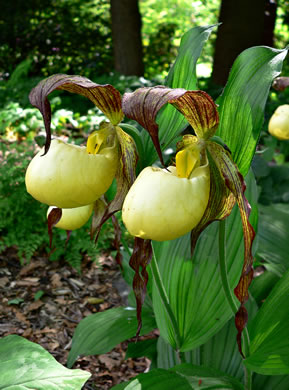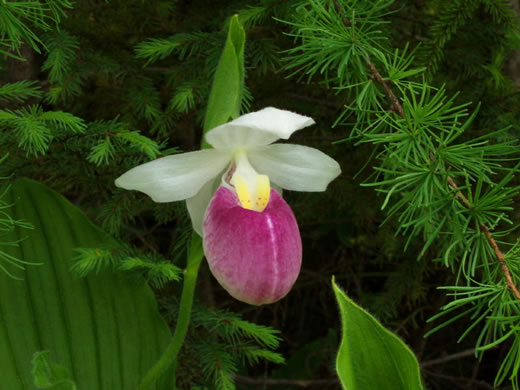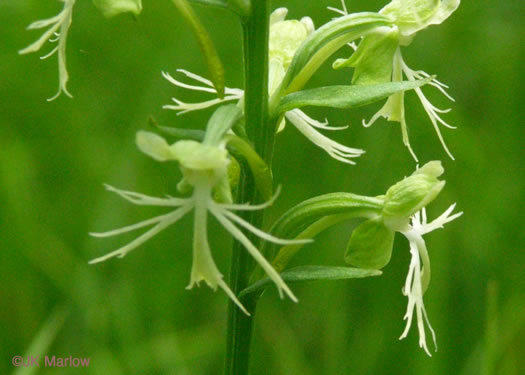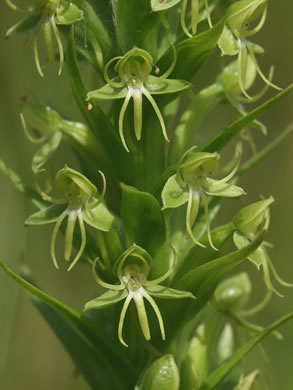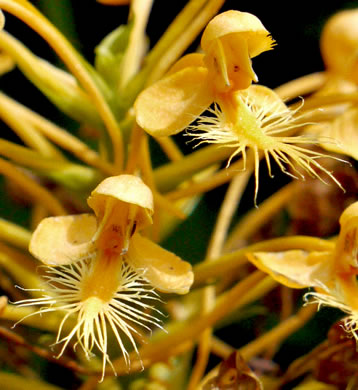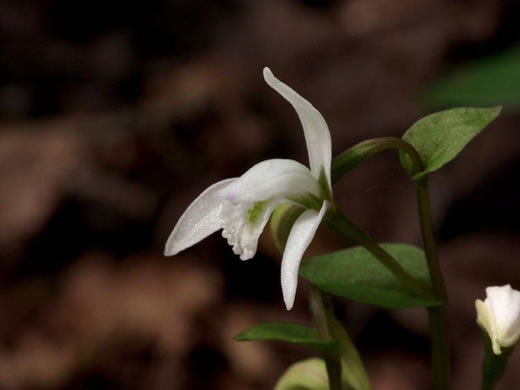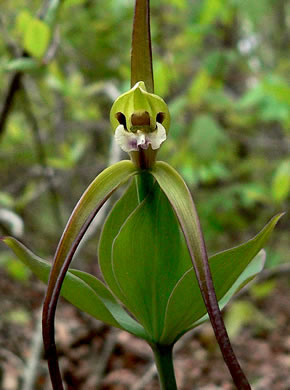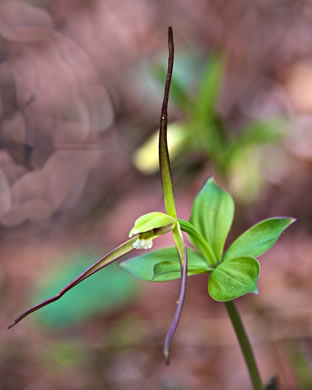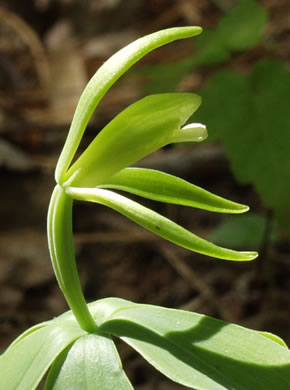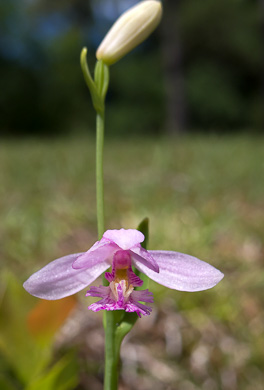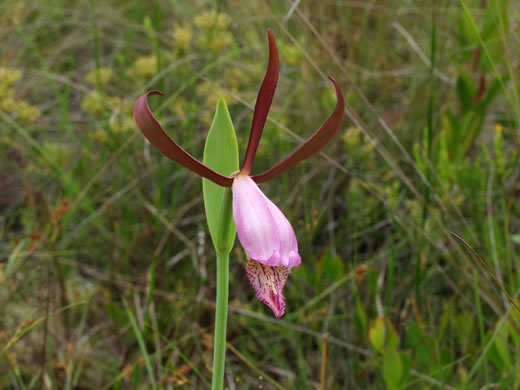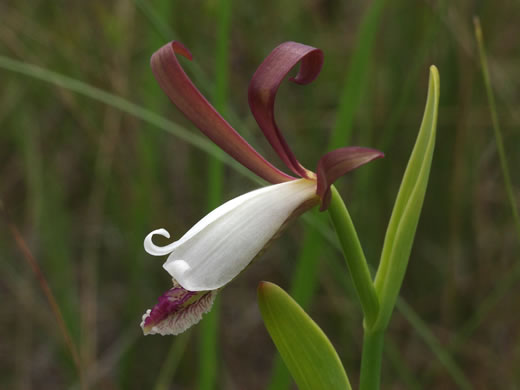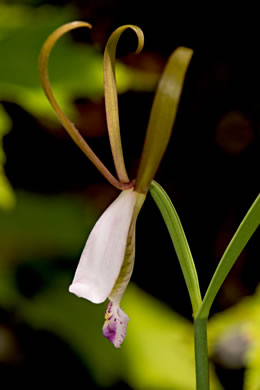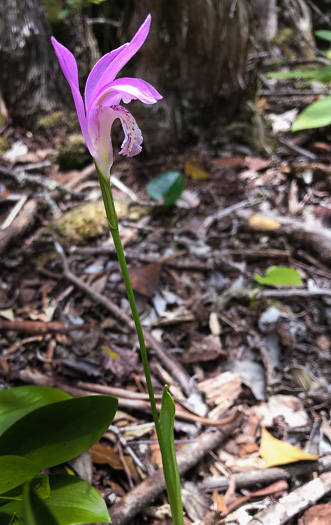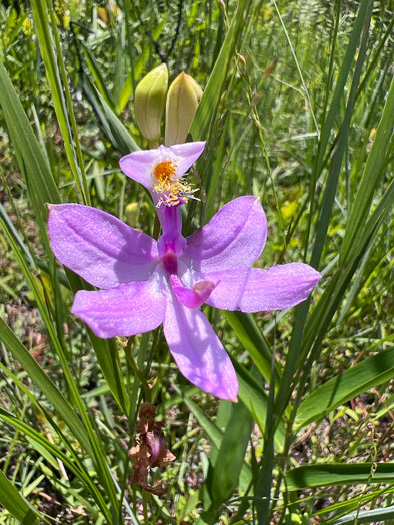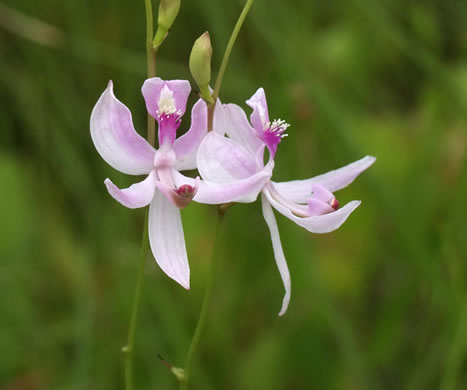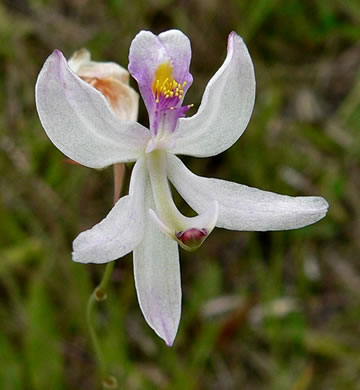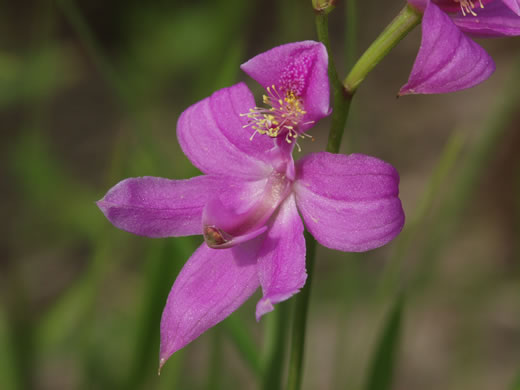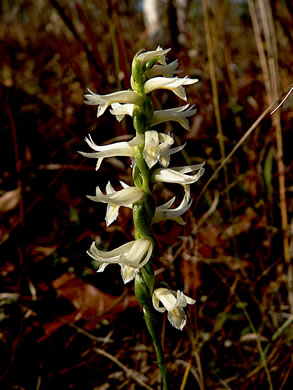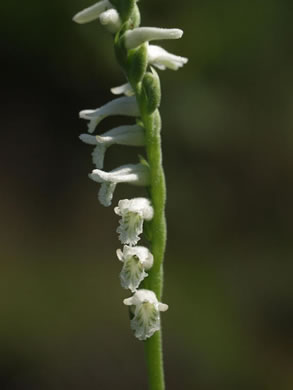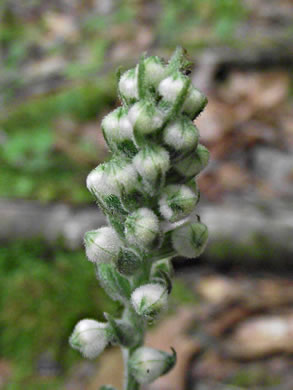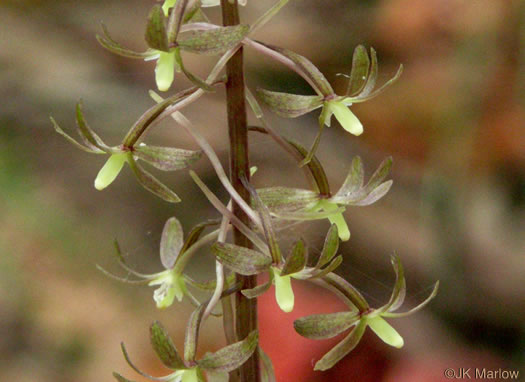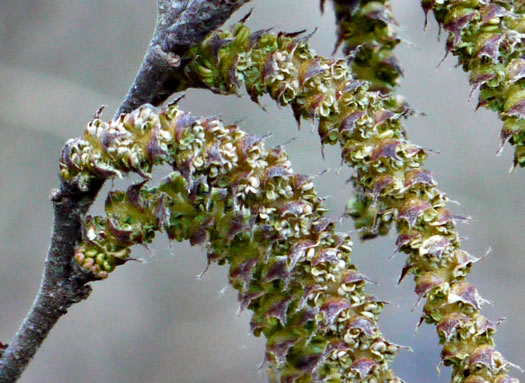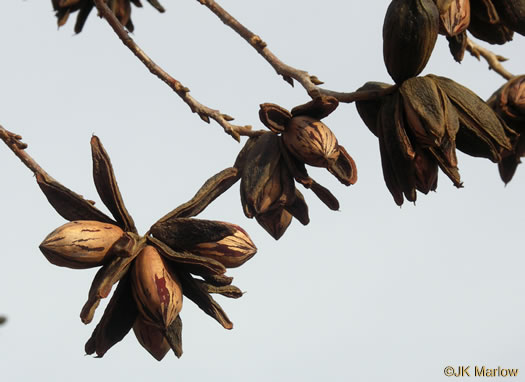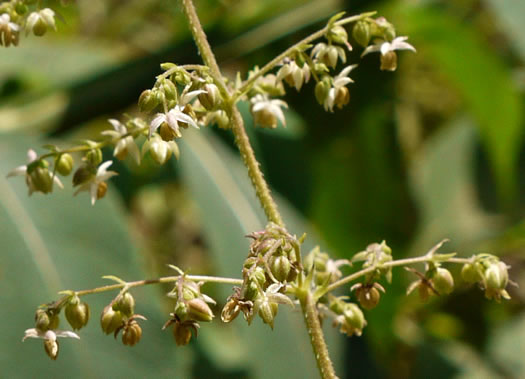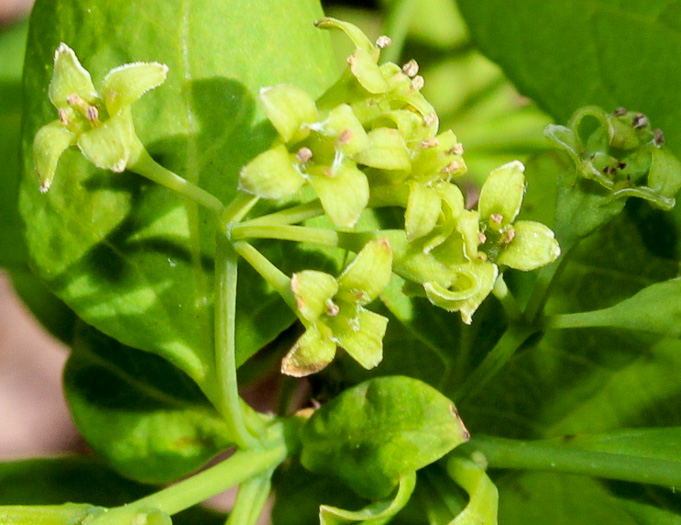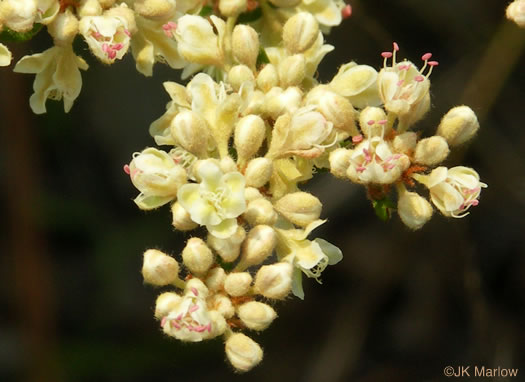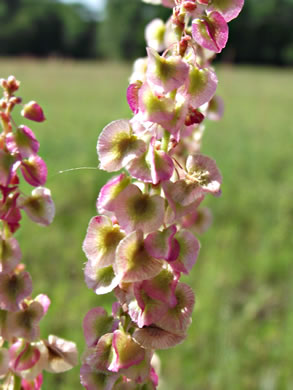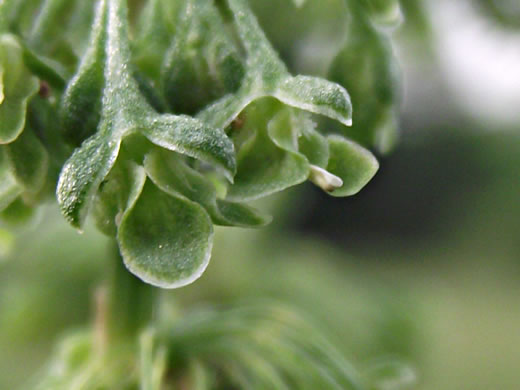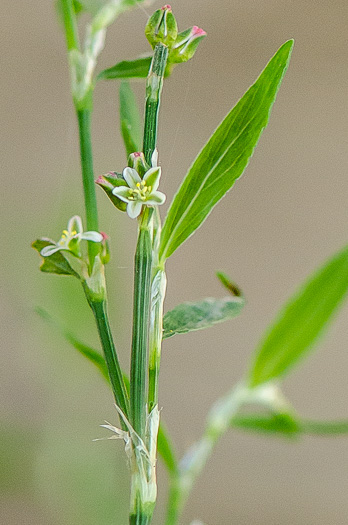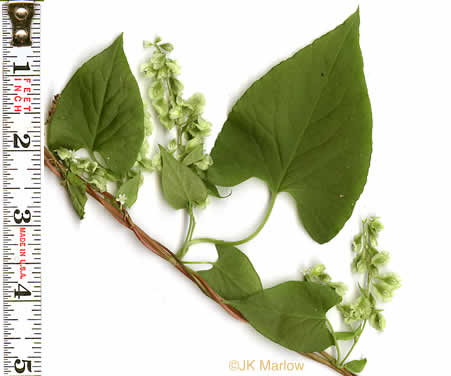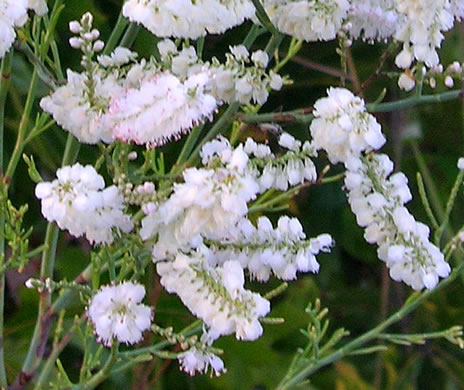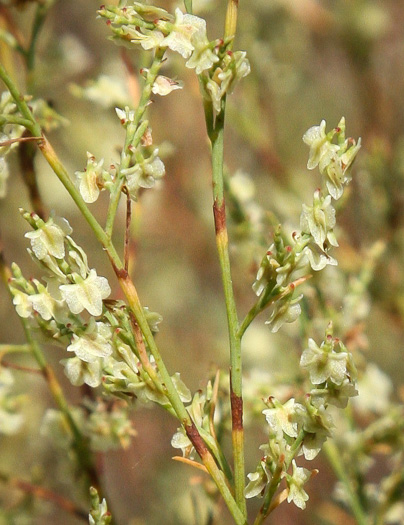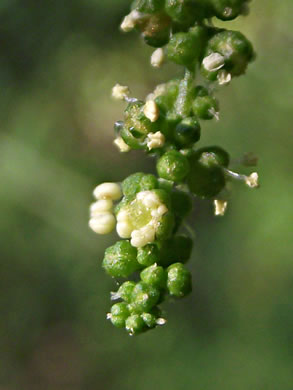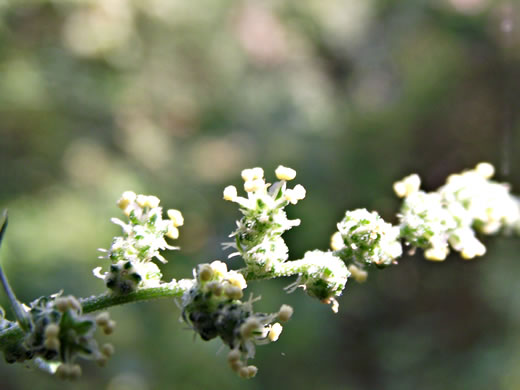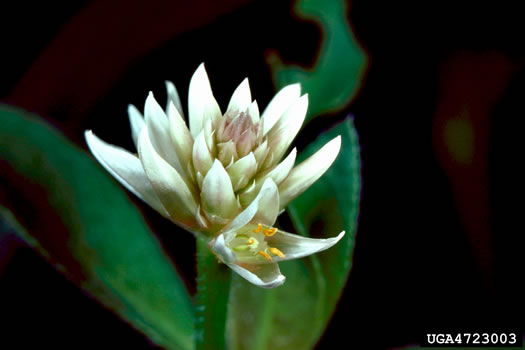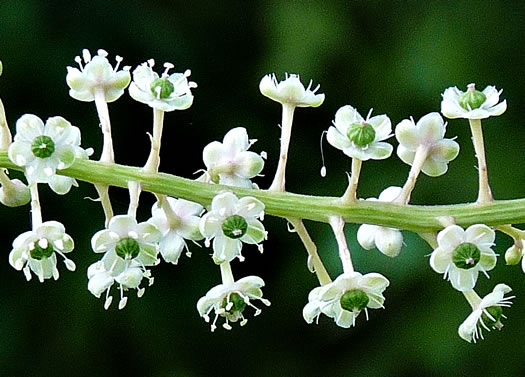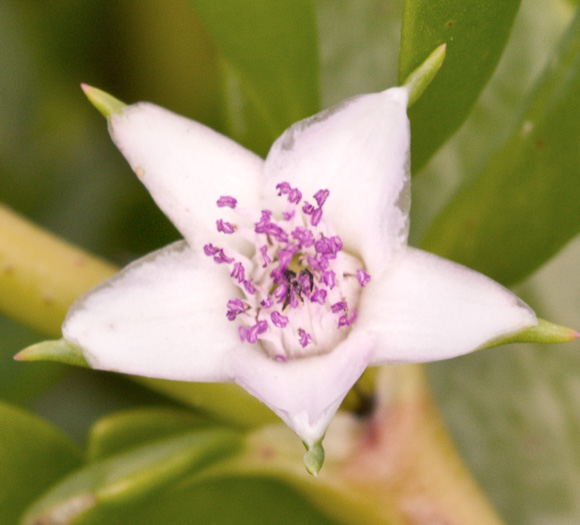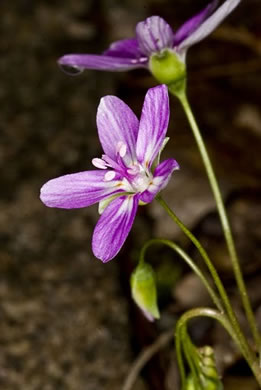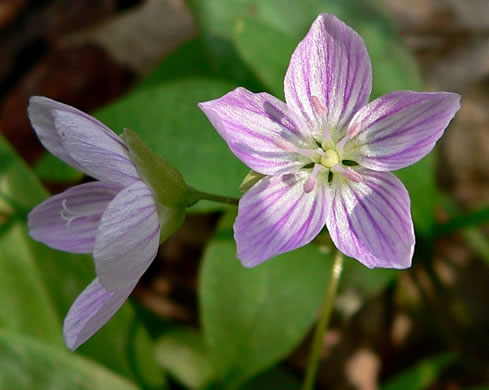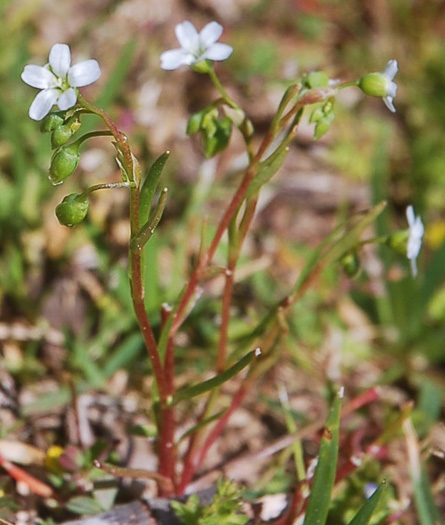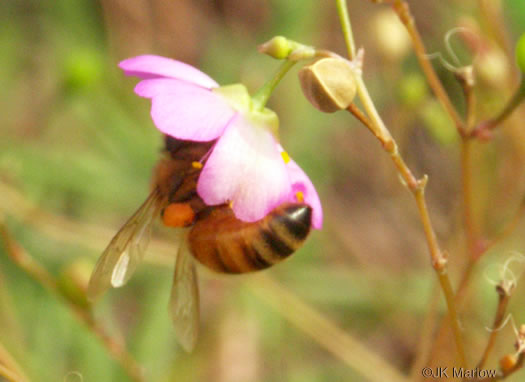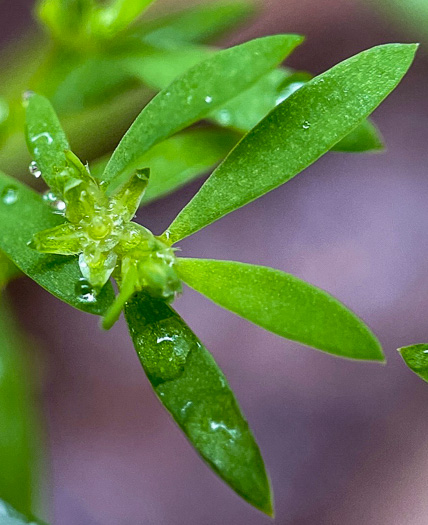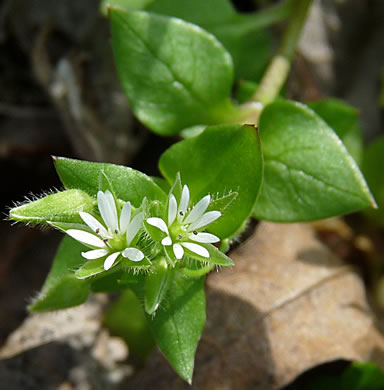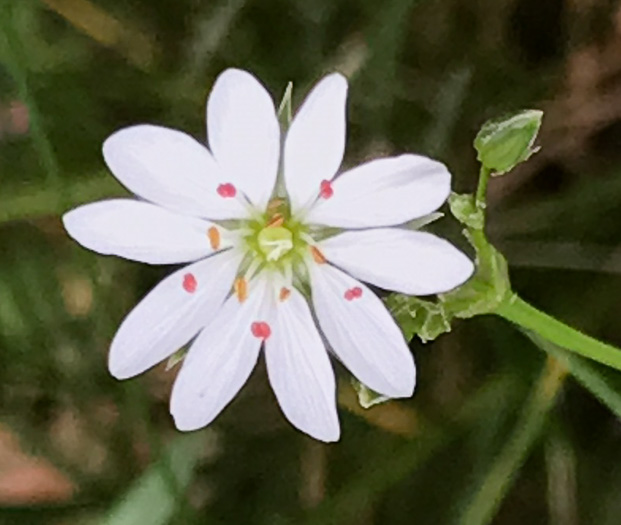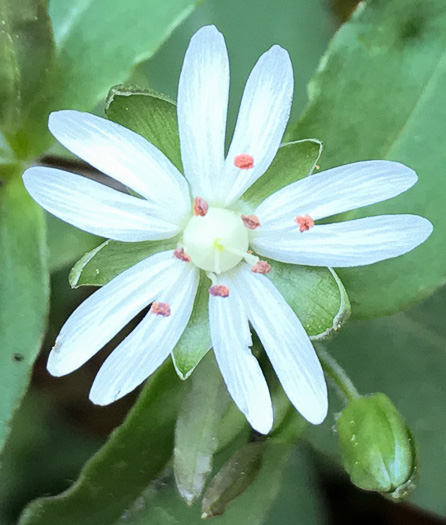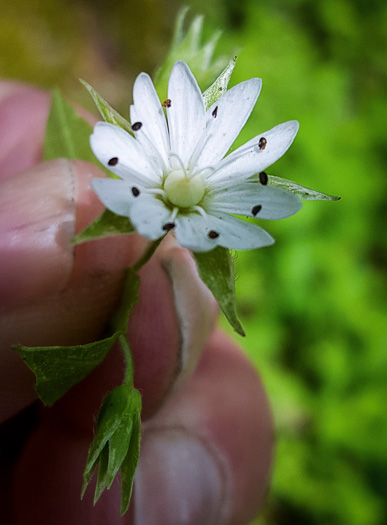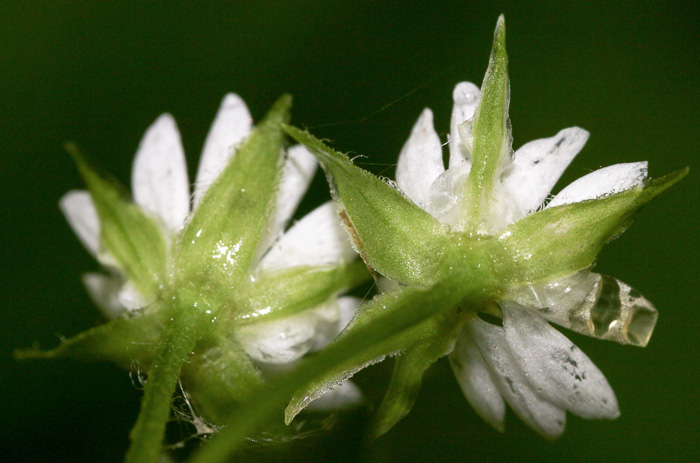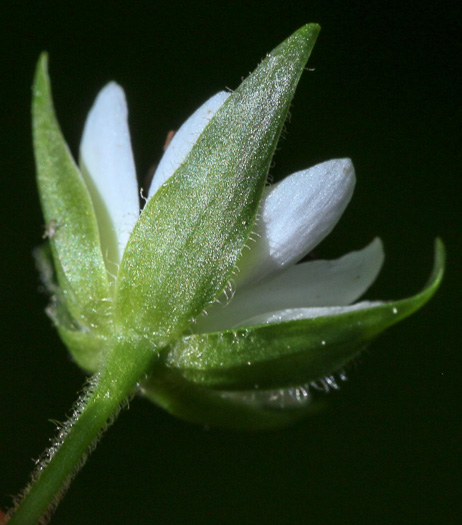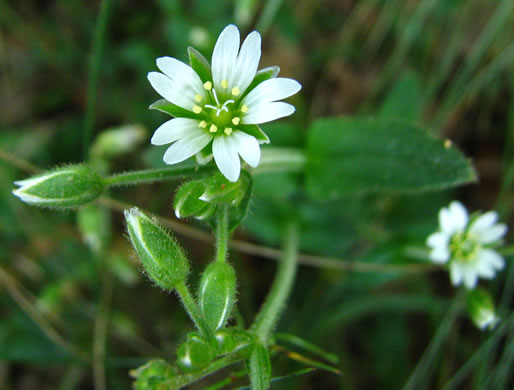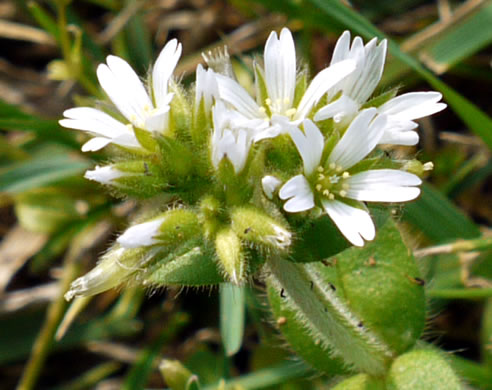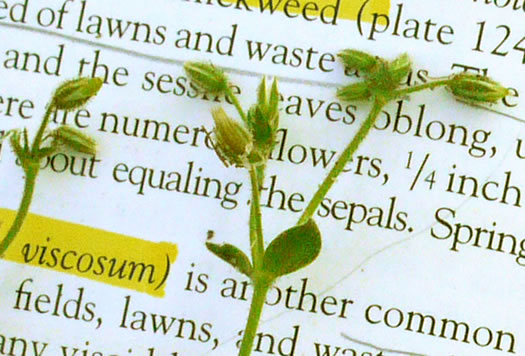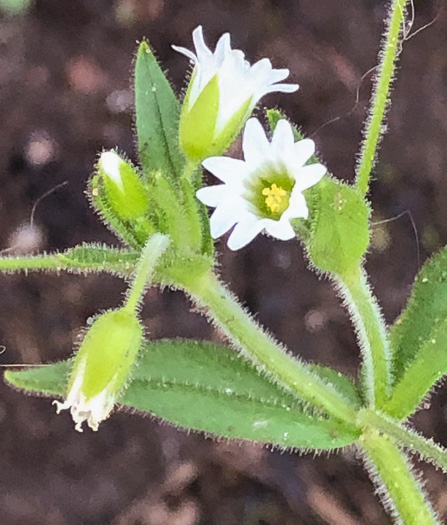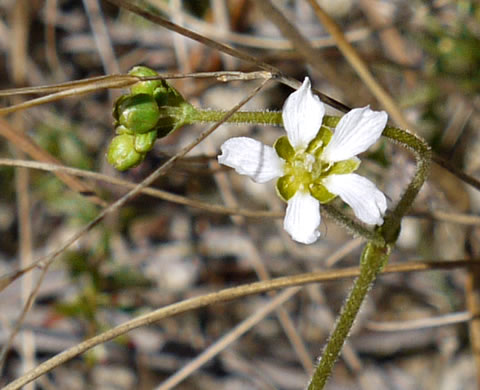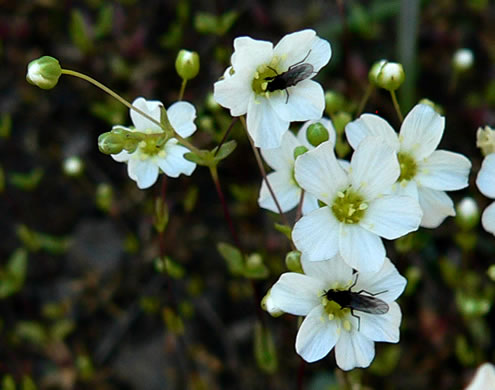Your search found 419 image(s) illustrating the term "sepals." For a written explanation, click on "sepals" in the Glossary.
PAGE 1 PAGE 2 PAGE 3 PAGE 4 PAGE 5 PAGE 6 PAGE 7
To see larger pictures, click or hover over the thumbnails.
To go to the plant's detail page, click its name.
 Kentucky Yellow Lady's Slipper,
Cypripedium kentuckiense
Kentucky Yellow Lady's Slipper,
Cypripedium kentuckiense
Purple-brown sepals & twisted petals; the lip a creamy to dull yellow pouch, per Wildflowers of Tennessee (Carman, 2005).
 Showy Lady's Slipper,
Cypripedium reginae
Showy Lady's Slipper,
Cypripedium reginae
Sepals are white, round-oval, 1.2-1.8" long, per Wildflowers of Tennessee (Carman, 2005).
 Ragged Fringed Orchid,
Platanthera lacera
Ragged Fringed Orchid,
Platanthera lacera
Sepals ovate to elliptic, obtuse, 4-6mm long, 3-4mm wide, per Vascular Flora of the Carolinas (Radford, Ahles, & Bell, 1968).
 Water-spider Orchid,
Habenaria repens
Water-spider Orchid,
Habenaria repens
The petals and lip resemble spider legs splayed against the plant's sepals, per Wild Orchids of South Carolina: A Popular Natural History (Fowler, 2005).
 Yellow Fringed Orchid,
Platanthera ciliaris
Yellow Fringed Orchid,
Platanthera ciliaris
A dorsal sepal acts as a "hood" and 2 lateral sepals are reflexed, per Wild Orchids of South Carolina: A Popular Natural History (Fowler, 2005).
 Three Birds Orchid,
Triphora trianthophoros var. trianthophoros
Three Birds Orchid,
Triphora trianthophoros var. trianthophoros
Petals and sepals may be pure white or white tipped with pink or purple, per Wild Orchids of South Carolina: A Popular Natural History (Fowler, 2005).
 Large Whorled Pogonia,
Isotria verticillata
Large Whorled Pogonia,
Isotria verticillata
The long dark sepals & gaping lip resemble a large insect waiting for prey, per Wild Orchids of South Carolina: A Popular Natural History (Fowler, 2005).
 Large Whorled Pogonia,
Isotria verticillata
Large Whorled Pogonia,
Isotria verticillata
3 long, narrow sepals are light green at base, dark purplish-brown at tips, per Wild Orchids of South Carolina: A Popular Natural History (Fowler, 2005).
 Small Whorled Pogonia,
Isotria medeoloides
Small Whorled Pogonia,
Isotria medeoloides
The flower is surrounded by three 1" sepals the same color as the leaves, per Wild Orchids of South Carolina: A Popular Natural History (Fowler, 2005).
 Rose Pogonia,
Pogonia ophioglossoides
Rose Pogonia,
Pogonia ophioglossoides
Sepals and petals usually pink, the lip tipped with deep purplish magenta, per Wild Orchids of South Carolina: A Popular Natural History (Fowler, 2005).
 Large Dragonhead Pogonia,
Cleistesiopsis divaricata
Large Dragonhead Pogonia,
Cleistesiopsis divaricata
Narrow mahogany-colored sepals stretch upward, are about as long as petals, per Wild Orchids of South Carolina: A Popular Natural History (Fowler, 2005).
 Appalachian Dragonhead Pogonia,
Cleistesiopsis bifaria
Appalachian Dragonhead Pogonia,
Cleistesiopsis bifaria
Narrow mahogany-colored sepals stretch upward, are about as long as petals, per Wild Orchids of South Carolina: A Popular Natural History (Fowler, 2005).
 Appalachian Dragonhead Pogonia,
Cleistesiopsis bifaria
Appalachian Dragonhead Pogonia,
Cleistesiopsis bifaria
Sepals (24-) 30-40 (-55) mm long; petals 21-36 mm long, per Weakley's Flora (2023).
 Bog-rose,
Arethusa bulbosa
Bog-rose,
Arethusa bulbosa
Petals and sepals generally point upward; lip curls downward like a tongue, per Wild Orchids of South Carolina: A Popular Natural History (Fowler, 2005).
 Common Grass-pink,
Calopogon tuberosus var. tuberosus
Common Grass-pink,
Calopogon tuberosus var. tuberosus
Sepals and lateral petals are nearly alike, spreading, 0.6-1" long, per Wildflowers of Tennessee (Carman, 2005).
 Pale Grass-pink,
Calopogon pallidus
Pale Grass-pink,
Calopogon pallidus
Lateral sepals are curved toward the stem and petals are curved forward, per Wild Orchids of South Carolina: A Popular Natural History (Fowler, 2005).
 Pale Grass-pink,
Calopogon pallidus
Pale Grass-pink,
Calopogon pallidus
Lateral sepals distinctively reflexed backward w their apices behind flower, per Atlantic Coastal Plain Wildflowers (Nelson, 2006).
 Oklahoma Grass-pink,
Calopogon oklahomensis
Oklahoma Grass-pink,
Calopogon oklahomensis
Lateral sepals weakly falcate to straight, per Weakley's Flora.
 Great Plains Ladies'-tresses,
Spiranthes magnicamporum
Great Plains Ladies'-tresses,
Spiranthes magnicamporum
Lateral sepals usually separate from other flower parts, curving in and up, per Native Orchids of the Southern Appalachian Mountains (Bentley, 2000).
 Grassleaf Ladies'-tresses,
Spiranthes praecox
Grassleaf Ladies'-tresses,
Spiranthes praecox
Lip has green veins radiating from its center. Lateral sepals appressed, per Wild Orchids of South Carolina: A Popular Natural History (Fowler, 2005).
 Downy Rattlesnake-orchid,
Goodyera pubescens
Downy Rattlesnake-orchid,
Goodyera pubescens
Sepals and petals glandular-pubescent on outer surface, per Vascular Flora of the Carolinas (Radford, Ahles, & Bell, 1968).
 Cranefly Orchid,
Tipularia discolor
Cranefly Orchid,
Tipularia discolor
Flowers have narrow sepals and petals and are about 1/2-3/4" wide, per Wild Orchids of South Carolina: A Popular Natural History (Fowler, 2005).
 Sweet-fern,
Comptonia peregrina
Sweet-fern,
Comptonia peregrina
Flowers without sepals or petals, per Guide to the Wildflowers of SC, 1st ed. (Porcher & Rayner, 2001).
 Pecan,
Carya illinoinensis
Pecan,
Carya illinoinensis
In Carya the husk is derived from bract and bracteoles not the sepals, per Evolution, Phylogeny, and Systematics of Juglandaceae (Manos & Stone, 2001).
 Japanese Hops,
Humulus scandens
Japanese Hops,
Humulus scandens
Five sepals, petals absent, per Vascular Flora of the Carolinas (Radford, Ahles, & Bell, 1968).
 Nestronia,
Nestronia umbellula
Nestronia,
Nestronia umbellula
Small greenish flowers w 4-5 petal-like sepals. Male flowers are in umbels, per Guide to the Wildflowers of SC, 1st ed. (Porcher & Rayner, 2001).
 Sandhill Wild-buckwheat,
Eriogonum tomentosum
Sandhill Wild-buckwheat,
Eriogonum tomentosum
Calyx of 2 whorls, each of 3 united sepals. Petals absent, per Vascular Flora of the Carolinas (Radford, Ahles, & Bell, 1968).
 Wild Dock,
Acetosa hastatula
Wild Dock,
Acetosa hastatula
Inner sepals cordate with a wide, membranous, erose wing, per Vascular Flora of the Carolinas (Radford, Ahles, & Bell, 1968).
 Wild Dock,
Acetosa hastatula
Wild Dock,
Acetosa hastatula
Enlarged wing-like heart-shaped sepals encase the nutlet, per Forest Plants of the Southeast and Their Wildlife Uses (Miller & Miller, 2005).
 Curly Dock,
Rumex crispus ssp. crispus
Curly Dock,
Rumex crispus ssp. crispus
Calyx has 3 narrow outer sepals & 3 inner sepals that expand in fruit, per Wildflowers of Tennessee, the Ohio Valley, and the Southern Appalachians (Horn, Cathcart, Hemmerly, & Duhl, 2005).
 Erect Knotweed,
Polygonum erectum
Erect Knotweed,
Polygonum erectum
Sepals green with a narrow yellowish or whitish margin, per Vascular Flora of the Carolinas (Radford, Ahles, & Bell, 1968).
 Climbing Buckwheat,
Fallopia convolvulus
Climbing Buckwheat,
Fallopia convolvulus
Sepals enlarging little as fruit matures, per Aquatic and Wetland Plants of Southeastern United States (Godfrey & Wooten, 1979 & 1981).
 Southern Jointweed,
Polygonella americana
Southern Jointweed,
Polygonella americana
Petals absent. Sepals to 3mm long, white, per Vascular Flora of the Carolinas (Radford, Ahles, & Bell, 1968).
 Common October-flower,
Polygonella polygama
Common October-flower,
Polygonella polygama
The 5 sepals are each about 1mm long and broad, 3 erect and 2 bent back, per Wildflowers of the Sandhills Region (Sorrie, 2011).
 Sandhill Jointweed,
Polygonella fimbriata
Sandhill Jointweed,
Polygonella fimbriata
This differs from all our other species in having the inner sepals fimbriate, per Weakley's Flora (2015).
 Mexican-tea,
Dysphania ambrosioides
Mexican-tea,
Dysphania ambrosioides
Each flower with 5 sepals, 5 stamens, and 2-3 stigmas; petals absent, per Vascular Flora of the Carolinas (Radford, Ahles, & Bell, 1968).
 Lambsquarters,
Chenopodium album var. album
Lambsquarters,
Chenopodium album var. album
Each flower with 5 sepals, 5 stamens, and 2-3 stigmas; petals absent, per Vascular Flora of the Carolinas (Radford, Ahles, & Bell, 1968).
 Alligator-weed,
Alternanthera philoxeroides
Alligator-weed,
Alternanthera philoxeroides
Each flower w 5 minute petals (actually sepals) surrounding yellow anthers, per A Field Guide for the Identification of Invasive Plants in Southern Forests (Miller, Chambliss, & Lowenstein, 2010).
 Common Pokeweed,
Phytolacca americana
Common Pokeweed,
Phytolacca americana
5-30 stamens that are as long as the sepals. Superior ovary, per Vascular Flora of the Carolinas (Radford, Ahles, & Bell, 1968).
 Common Pokeweed,
Phytolacca americana
Common Pokeweed,
Phytolacca americana
Flowers have 5 round greenish-white or pinkish petaloid sepals [no petals], per Wildflowers of the Southern Mountains (Smith, 1998).
 Large Sea-purslane,
Sesuvium portulacastrum
Large Sea-purslane,
Sesuvium portulacastrum
Flowers on pedicels 3mm or longer. Sepals green outside and pink within, per Wildflowers of the Eastern United States (Duncan & Duncan, 1999).
 Carpetweed,
Mollugo verticillata
Carpetweed,
Mollugo verticillata
A few 3/16" flowers from each node. Sepals white but green-striped beneath, per Wildflowers of the Southern Mountains (Smith, 1998).
 Spring-beauty,
Claytonia virginica var. virginica
Spring-beauty,
Claytonia virginica var. virginica
Two sepals, each 4-9mm long, per Vascular Flora of the Carolinas (Radford, Ahles, & Bell, 1968).
 Carolina Spring-beauty,
Claytonia caroliniana
Carolina Spring-beauty,
Claytonia caroliniana
Sepals persistent, leaflike, unequal, 3-5mm, per Flora of North America.
 Narrow-leaved Montia,
Montia linearis
Narrow-leaved Montia,
Montia linearis
Inflorescences terminal, of 2-8 flowers; sepals 2, persistent and unequal; petals 5, white, per Flora of North America.
 Appalachian Fameflower,
Phemeranthus teretifolius
Appalachian Fameflower,
Phemeranthus teretifolius
Sepals caducous [falling off early], per Vascular Flora of the Carolinas (Radford, Ahles, & Bell, 1968).
 Silverling,
Paronychia argyrocoma
Silverling,
Paronychia argyrocoma
Flowers mostly hidden by conspicuous silvery bracts; sepals white on margins, per Wildflowers of Tennessee (Carman, 2005).
 Mountain Nailwort,
Paronychia montana
Mountain Nailwort,
Paronychia montana
Sepals not petaloid, green, sometimes scarious-margined; perigynous zone ~ shorter than sepals, per Weakley's Flora (2023).
 Common Chickweed,
Stellaria media
Common Chickweed,
Stellaria media
Sepals usually glandular-hairy w obtuse apex, longer than or equaling petals, per Flora of North America.
 Lesser Stitchwort,
Stellaria graminea
Lesser Stitchwort,
Stellaria graminea
The 5 petals exceed the sepals and are cleft almost to the base, per Wildflowers of the Southern Mountains (Smith, 1998).
 Star Chickweed,
Stellaria pubera
Star Chickweed,
Stellaria pubera
Sepals are acute to obtuse and shorter than the petals, per Wildflowers of Tennessee (Carman, 2005).
 Tennessee Starwort,
Stellaria corei
Tennessee Starwort,
Stellaria corei
Very similar to S. pubera but differs in its long-acuminate sepals, per Flora of North America.
 Tennessee Starwort,
Stellaria corei
Tennessee Starwort,
Stellaria corei
Similar to S. pubera, but the sepals are acuminate, and equal to or longer than the petals, per Wildflowers of Tennessee (Carman, 2005).
 Tennessee Starwort,
Stellaria corei
Tennessee Starwort,
Stellaria corei
Sepals 7-11(-12)mm long, acuminate, ciliate, but more-or-less glabrous on the back, per Weakley's Flora (2022).
 Common Mouse-ear Chickweed,
Cerastium fontanum ssp. vulgare
Common Mouse-ear Chickweed,
Cerastium fontanum ssp. vulgare
Flowers 1/4" wide, the petals cleft and about equaling the sepals, per Wildflowers of the Southern Mountains (Smith, 1998).
 Sticky Mouse-ear,
Cerastium glomeratum
Sticky Mouse-ear,
Cerastium glomeratum
Sepals green, apex very acute, usually w glandular hairs & long white hairs, per Flora of North America.
 Gray Mouse-ear Chickweed,
Cerastium brachypetalum
Gray Mouse-ear Chickweed,
Cerastium brachypetalum
Pedicels erect or ascending, 6-15 mm, shaggy. Sepals densely pubescent, per Flora of North America.
 Nodding Mouse-ear Chickweed,
Cerastium nutans var. nutans
Nodding Mouse-ear Chickweed,
Cerastium nutans var. nutans
Sepals ~1/5" long & pointed; petals bisected, as long or longer than sepals, per Vascular Plants of North Carolina.
 Carolina Sandwort,
Geocarpon carolinianum
Carolina Sandwort,
Geocarpon carolinianum
Sepals obtuse at the tip, per Weakley's Flora (2015).
 Piedmont Sandwort,
Geocarpon uniflorum
Piedmont Sandwort,
Geocarpon uniflorum
Pedicels and sepals glabrous, petals 1-7mm long, per Weakley's Flora (2015).

